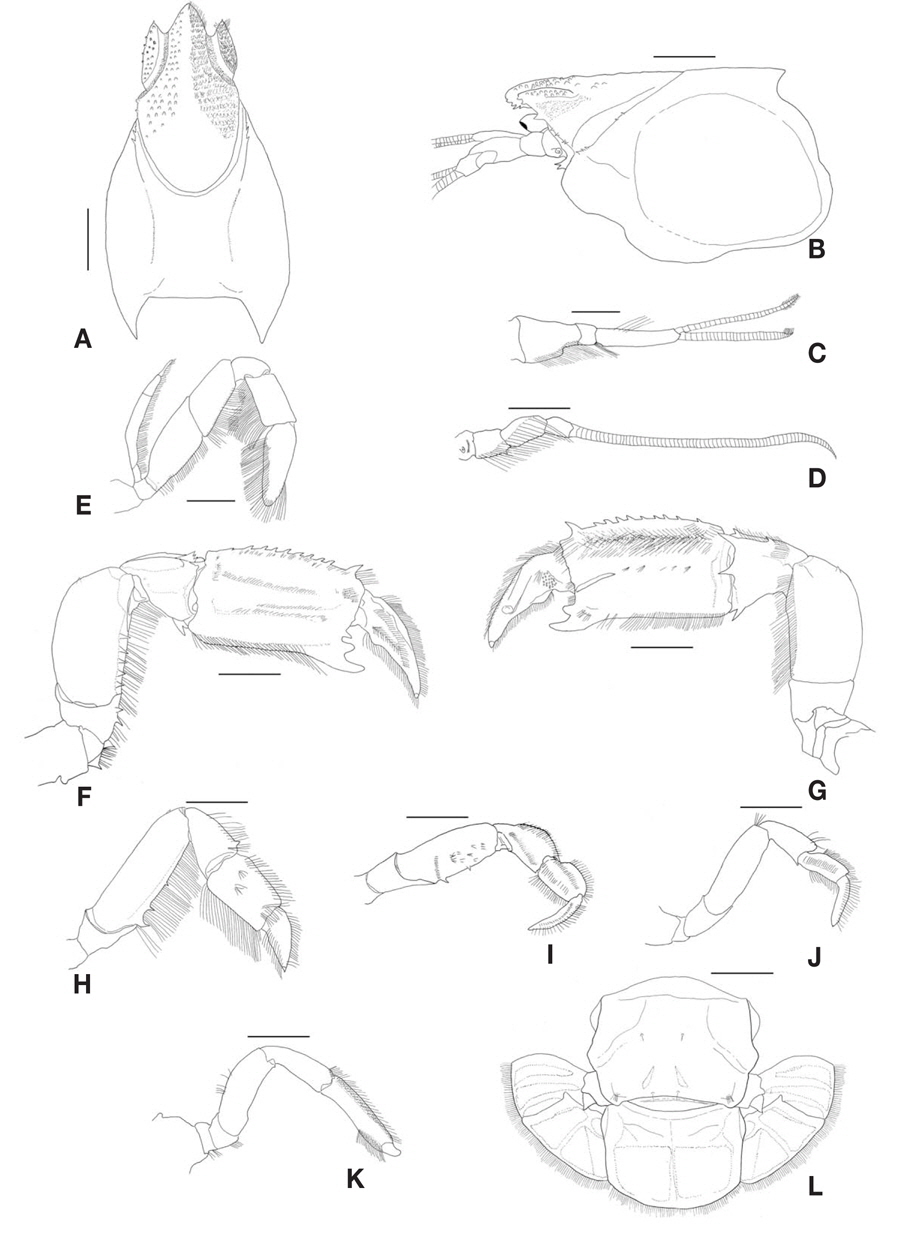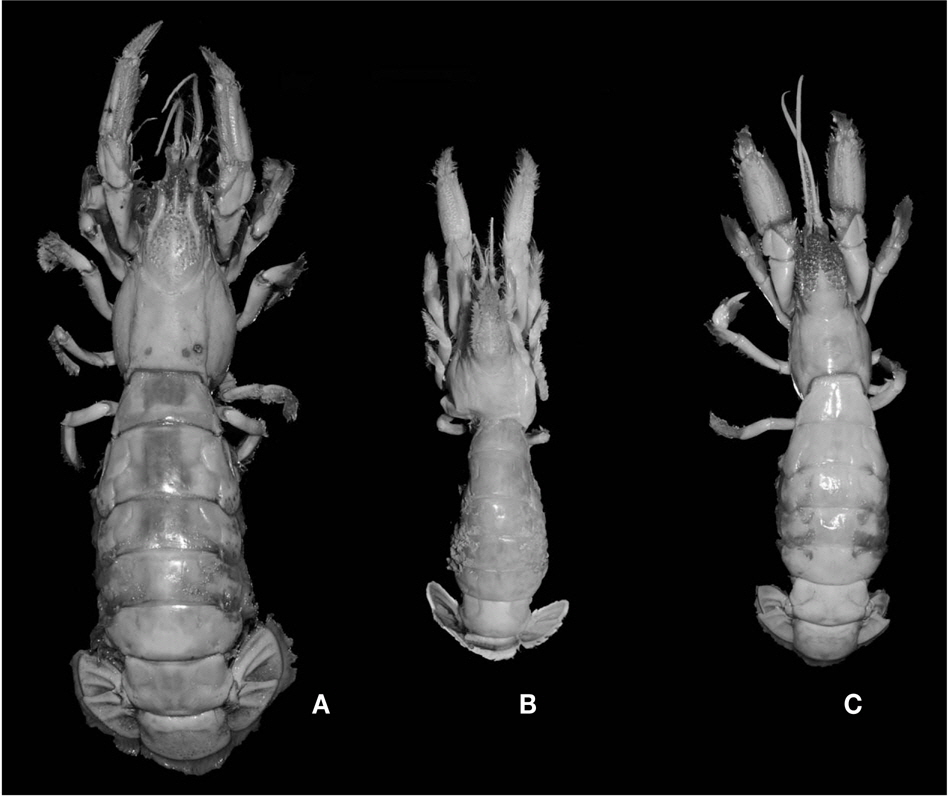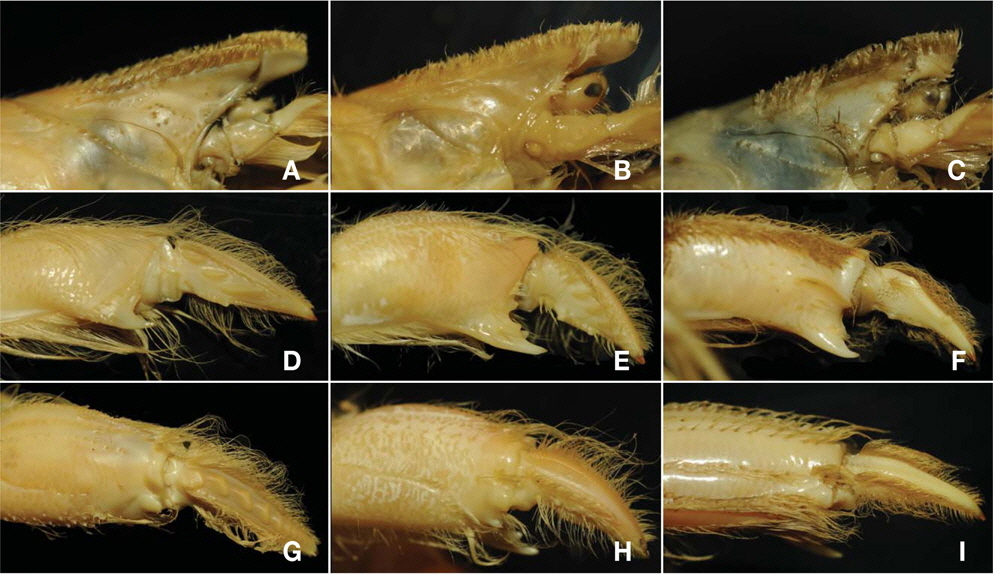



Specimens of Austinogebia wuhsienweni (Yu, 1931) previously recorded from China to Japan were collected at a manila clam farm of 0.5 m depth in Hongseong, Yellow Sea. They were briefly described and illustrations included color photographs, since this was the first record of this rare species from Korean waters. Three species of Upogebiidae are known from Korean waters: Upogebia major (De Haan, 1839), U. issaeffi (Balss, 1913), and A. wuhsienweni (Yu, 1931). They are similar to each other, however, the presence of the ventral spines of the rostrum, a proximal knob on the lateral margin of the uropodal endopod, and a longitudinal carina on the inner surface of the palm of the male first pereiopod can easily distinguish the present species from the two species of Upogebia.
Presently, the family Upogebiidae Borradaile, 1903 includes 179 species of 13 genera worldwide, however, only two species of the genus
Carapace length and total length are abbreviated as “CL” and “TL”, which are used as an indication of the size of the specimen. CL is measured from the tip of the rostrum to the posterior border of the carapace, while TL is measured from the tip of the rostrum to the posterior border of the telson. All specimens were preserved in 95% ethanol. Materials examined in this study are deposited at the Tidal Flat Research Institute, National Fisheries Research and Development Institute.
Order Decapoda Latreille, 1803 Family Upogebiidae Borradaile, 1903 1*Genus Austinogebia Ngoc-Ho, 2001
Material examined. 2♂♂ (CL 21.3 mm, TL 69.1 mm; CL 22.6 mm, TL 73.3 mm), Korea coast of Yellow Sea, Hongseong (36˚34.4′N, 126˚27.4′E), at a manila clam farm, muddy sand bottom,16 May 2014, An HM, by shovel.
Description. Front trilobed (Fig. 1A) covered with dense setae, bearing rows of rounded teeth; rostrum (Figs. 1B, 3C) with 6-7 lateral teeth and 4 ventral spines; blunt tip projecting far beyond eyes; lateral frontal lobe projecting anteriorly, with 2 ventral spines. Carapace (Fig. 1A, B) covered with dense setae on gastric region, with 3-4 spines on anterolateral margin, gastric ridge divided by weak mid-dorsal notch, hepatic spine absent; linea thalassinica terminating in anterior thoracic region.
Antennular peduncle (Fig. 1C) 3-segmented, segment 2 shortest, segment 3 longest.
Antennal peduncle (Fig. 1D) 3-segmented, segment 1 with small subdistal spine ventrally, scaphocerite terminating in blunt tooth.
Epistome (Fig. 1B) with 2 distinct spines.
Third maxilliped (Fig. 1E) with exopod failing to reach distal margin of merus; epipod present.
First pereiopod (Figs. 1F, G, 3F, I) subcheliform; basis (Fig. 1F) with sharp ventral spine; ischium (Fig. 1F) with 2 spines on ventral margin; merus with subdistal spine on dorsal margin and 5 spines on ventral margin (Fig. 1F); carpus (Fig. 1G) bearing longitudinal crest on dorsal surface with conspicuous spinules and terminating in spine, large distal spine on ventral margin, inner surface with 3 spines on distal margin; propodus 1.5 times as long as broad, dorsal margin with row of 10 spines, of which distal one largest, outer surface (Figs. 1F, 3F) with distal spine near fixed finger; fixed finger curved distally, with large rounded tooth on middle of cutting edge, inner surface (Figs. 1G, 3I) with translucent longitudinal carina on distal fourth; dactylus two-thirds as long as propodus, with corneous tip, dorsal surface with shallow longitudinal median groove, dorsomesial surface with longitudinal carina terminating large tubercle distally, large tooth on cutting edge proximally.
Second pereiopod (Fig. 1H) shorter than first pereiopod; merus with subdistal spine on dorsal margin, 3 spines on ventral margin increasing in size proximally; carpus bearing distal spine on dorsal margin; propodus and dactylus relatively broad, unarmed.
Third pereiopod (Fig. 1I) shorter than second pereiopod; merus with 2 spines on ventral margin; carpus and propodus noticeably convex on dorsal margins; dactylus slender.
Fourth pereiopod (Fig. 1J) as long as third pereiopod, unarmed; dactylus slender.
Fifth pereiopod (Fig. 1K) unarmed; carpus slender; propodus longer than carpus, slender; dactylus extremely short.
First pleopod absent.
Uropod (Fig. 1L) broad; protopod with acute spine on posterior margin; endopod reaching beyond posterior margin of telson, proximal knob on lateral margin, with 2 longitudinal ridges; exopod convex on lateral margin, with 3 ridges; posterior margins of endopod and exopod without spinules.
Telson (Fig. 1L) 1.4 times as broad as long; posterior margin slightly convex.
Color. The body is light reddish brown overall. Pereiopods and uropod are ivory and hairs are light brown. Cobalt blue individuals are observed rarely in field.
Distribution. Vietnam, Taiwan, China, Japan (Sakai, 2006), and now Korea.
Remarks. The present materials agree well with the original description and figures by Yu (1931). As, they represent the first record of this rare species from Korean waters, three species of Upogebiidae are known in this region:


